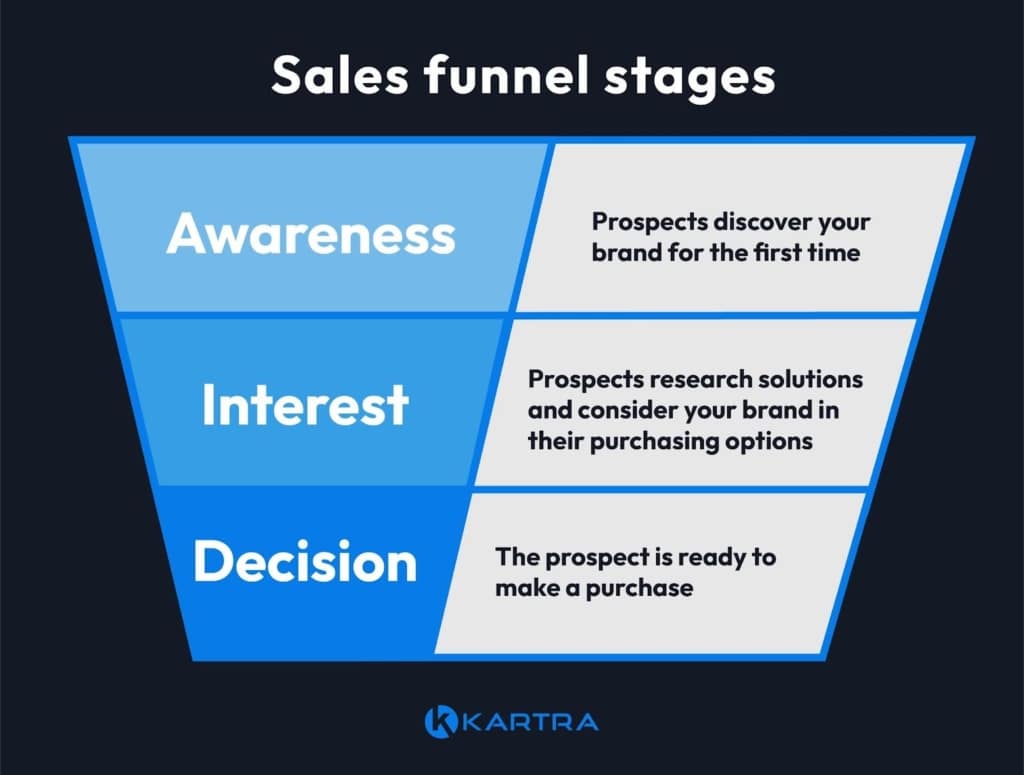- Create
- Market
- Scale
create
market
If you’re challenged by the marketing side of running an online business, you’re not alone. Many content creators are unsure about how to successfully promote their product, whether it’s a new course or a published course that just isn’t gaining traction.
The good news is that marketing an online course is a lot more intuitive than you might think — and there is an abundance of marketing tools that streamline your to-do list. Here at Kartra, we’re passionate about giving online course creators everything they need to grow a sustainable online business around their expertise.
Read on for our top marketing advice that will put you ahead of the competition!
1. Marketing is about earning trust
2. Invest in organic marketing strategies for long-term growth
3. Use paid marketing channels strategically
4. Inspire loyalty with a recognizable brand
Good marketing doesn’t impose on others — it presents solutions to real problems and builds trust. This principle is especially important to remember when your product isn’t consumable. Your customers are investing their resources in something they expect to improve their lives! In order to make that purchase decision, they need to trust you.
To build a successful, sustainable business from course creation, you can’t think in terms of the product itself. You need an online community that believes in the value of what you have to say.
For course creators, the best way to build trust with your target audience is to create high-quality content as part of a long-term, organic marketing strategy.
Unlike paid tactics, such as running Facebook ads or Google ads, organic marketing tactics position you as an authority on a topic. As people discover your content and find it valuable for their lives, they’ll want to know more!
There are countless, creative ways to publish content online. Try to not get distracted by all the options and simply focus on the content marketing tactics that:
Here are a few ideas to get you started!
Consistency with select channels will prove much more effective than having a sporadic presence on a wide variety of media! Identify which social media platforms matter to your audience and contribute to meaningful conversations around your area of expertise.
Forums such as Quora discussions or Facebook groups are other great places to share your knowledge and learn about your customer base.
Just be sure to add value to conversations and don’t jump too quickly to promoting a product (some groups don’t allow selling at all!)
Even though it predates social media, email remains one of the most effective marketing channels. Email is easy to personalize, isn’t subject to algorithm changes, and best of all — you own your email list!
Remember that for an organic marketing strategy to work, your marketing efforts need to bring value to your audience. Use email sequences to educate, engage, and strategically promote your course.

Online business expert Louise Henry delivers a weekly newsletter to her contact list
When someone goes to Google for an answer or a resource, it’s a huge opportunity for your website to show up in the search results. Developing content that aligns with an online search query is part of a strategy called search engine optimization (SEO).
Successful SEO does require keyword research and other behind-the-scenes work, but it’s not about technical hacks or tricks for getting content to rank. This long-term strategy involves developing website content that is as helpful as possible to your target audience. Learn more in our guide to How Content SEO Works.
A lead magnet is something of value that you trade for a potential customer’s contact information so you can add them to an email marketing list.
Strategically placed in landing pages or pop-ups, a lead magnet is often the starting point in the relationship between your business and a future customer. Many types of content can be used for lead magnets — PDF downloads, checklists, mini-courses — anything your target audience would find useful.

Parenting coach Myla Leinweber offers free parenting resources to website visitors
Helpful information doesn’t always have to be written! Events such as webinars, workshops, and live Q&As are valuable opportunities to educate your audience, answer questions, and establish a meaningful connection. Course creators are uniquely qualified to host these types of events, with a background in designing learning experiences and an existing library of materials.
As content becomes a more significant part of your online course marketing strategy, don’t forget to repurpose resources. You might have more content to work with than you think!
Producing content across multiple digital marketing channels is far easier when you reuse the work you’ve already done. And your library of useful content will only expand as your business grows!
Sometimes you need a quick way to access new audiences and drive sales while working on long-term, organic strategies. Here are a couple paid marketing tactics to consider.
Search engine and social media ads can be very effective at raising brand awareness and boosting enrollment. And while advertising is a more disruptive marketing method than an organic strategy, it doesn’t have to mean outright promoting your services.
For example, running ad reels on social platforms like Instagram or LinkedIn can be a great way to get people interested in what you have to say.
If you decide to run paid ads, here’s what we recommend:
Target a specific audience with a specific message: It usually isn’t worth it for small businesses to run broad ad campaigns. Your ad campaign should focus on reaching a specific audience with a highly curated message that resonates with their values and pain points.
Set strategic ad parameters: Online ads give you control over where your ads show up and to whom. Make sure you understand ad settings and use them to your advantage – maximizing your ad budget and honing in on the most successful strategies.
Create a logical path for the user: What action should they take after they see the ad? Depending on what you want the ad to accomplish, you may not even link the ad directly to your service page — it could instead funnel users toward a lead magnet that keeps them engaged with your brand.
An affiliate program is a great way to build an army of salespeople without the expense of hiring employees. Course creators have a unique advantage when it comes to finding affiliates because there’s a network of past students to recruit. Students are ideally situated to become course advocates, consultants, or tutors who can bring in new clients and be rewarded for their efforts. Affiliate marketing software lets small business owners easily onboard, pay, and manage these affiliates with minimal interruption to business operations.
One of the fundamental principles of good marketing is to build a cohesive brand image — not just a helpful product. Course creators need their users to have a “tribe mentality” — a long-term commitment to the brand as a whole instead of a short-term commitment to a particular offering.
This emphasis on relationships instead of transactions helps to ensure your brand grows sustainably instead of building sudden interest that tapers off!
Focus on making your brand consistent, different, and appealing to your target audience.
From your social media ads to the learning experience itself, your brand’s design and tone should communicate the same thing. Conflicting messages won’t stick!
Don’t worry if writing or design isn’t your strong suit. Take advantage of pre-designed email templates, intuitive landing page builders, and other automated marketing tools that you can use without coding or design skills.
And although you may need to hone certain marketing skills, it’s good to reflect your own, genuine style throughout your website and course content.
If you’re not sure what your brand should be saying — go back to the reasons why you created the course in the first place. Identify your specific target audience and hammer out a clear value proposition that explains exactly what the course does and for whom.
Strong brands aren’t easily confused with each other! Get inspiration from other course creators, but don’t copy what’s already out there. Your brand should be identifiable and easy to remember because it’s something people aren’t used to seeing.
And differentiation isn’t just about design — creative terminology is another effective means for standing out from the crowd. Bring a unique angle to the way that you describe your products, audience, and what you teach.
Analyze your target audience’s values, goals, and pain points. Even the way that they talk. What language will resonate with them? What tone would they appreciate? Your brand should strike a chord with a particular audience.
It’s even an advantage if the brand dissuades potential students who wouldn’t be a good fit for the course. You want eager learners who will love the course, follow your brand, and bring in referrals.
One of the most common — and detrimental — marketing mistakes is expecting isolated marketing tactics to convince someone to buy right then and there.
When was the last time you bought something immediately after watching a commercial from a brand you’d never heard of before?
Most people take a long and winding path before they make a purchase — especially if they’re investing in their own education and personal development.
This concept is called a buyer journey, and businesses build sales funnels to move people through each stage. You’ll be ahead of the pack if you market your course with this principle in mind.

Start with the bottom of the funnel — developing key assets like your course sales page and checkout page. These are the resources your customers need to enroll. Next, create resources for people who need more information and more persuading — such as a program overview and a success page with testimonials and other social proof.
Once those bottom-of-funnel assets are established, you’ll be prepared to turn your attention lead generation — educating through valuable content and perhaps running ads as needed.
You can also apply the sales funnel concept to individual marketing campaigns, such as an email sequence that starts with educational content and ends with a direct call-to-action to purchase your course.
Setting up sales funnels is another step you don’t have to do from scratch! Kartra users have access to a sales funnel builder and done-for-you templates that take the legwork out of designing marketing campaigns.
There are too many possible marketing tactics to try them all!
Don’t feel obligated to be everywhere at once. Focus your efforts on the channels that bring you steady leads, and be willing to adapt your strategy based on what works and what doesn’t. Successful course creators rarely take a straight path!
This is one reason we’re excited about the possibilities for course creators who use Kartra’s all-in-one platform.
Kartra is designed so you can build your online course business from the ground up without stitching together software programs as you grow. Instead, you have access to all the features you need — all in one place — for every step of the journey.
Kartra’s online course platform equips entrepreneurs with all the most important tools to create, market, and scale their business:
…and there’s more!